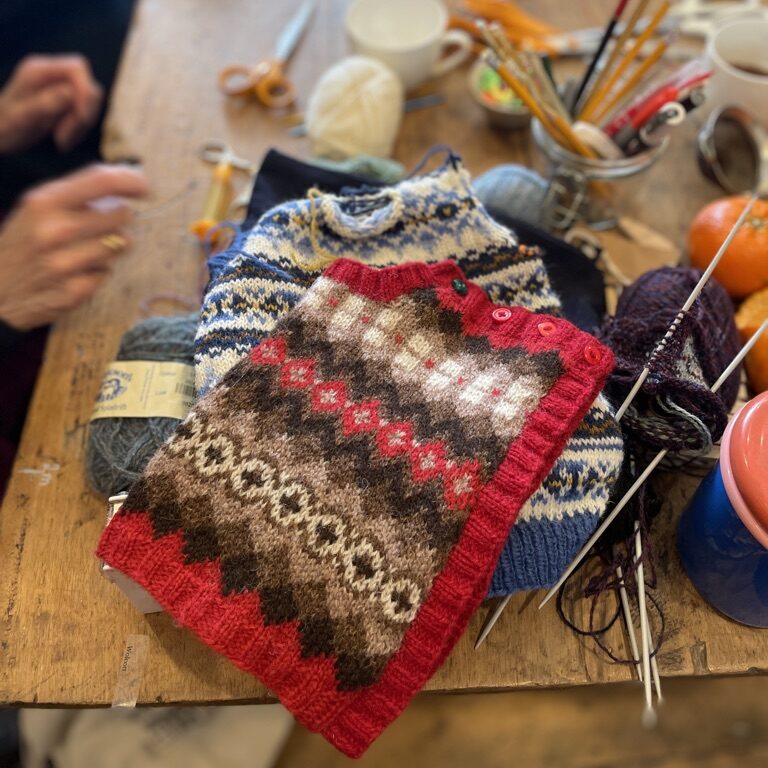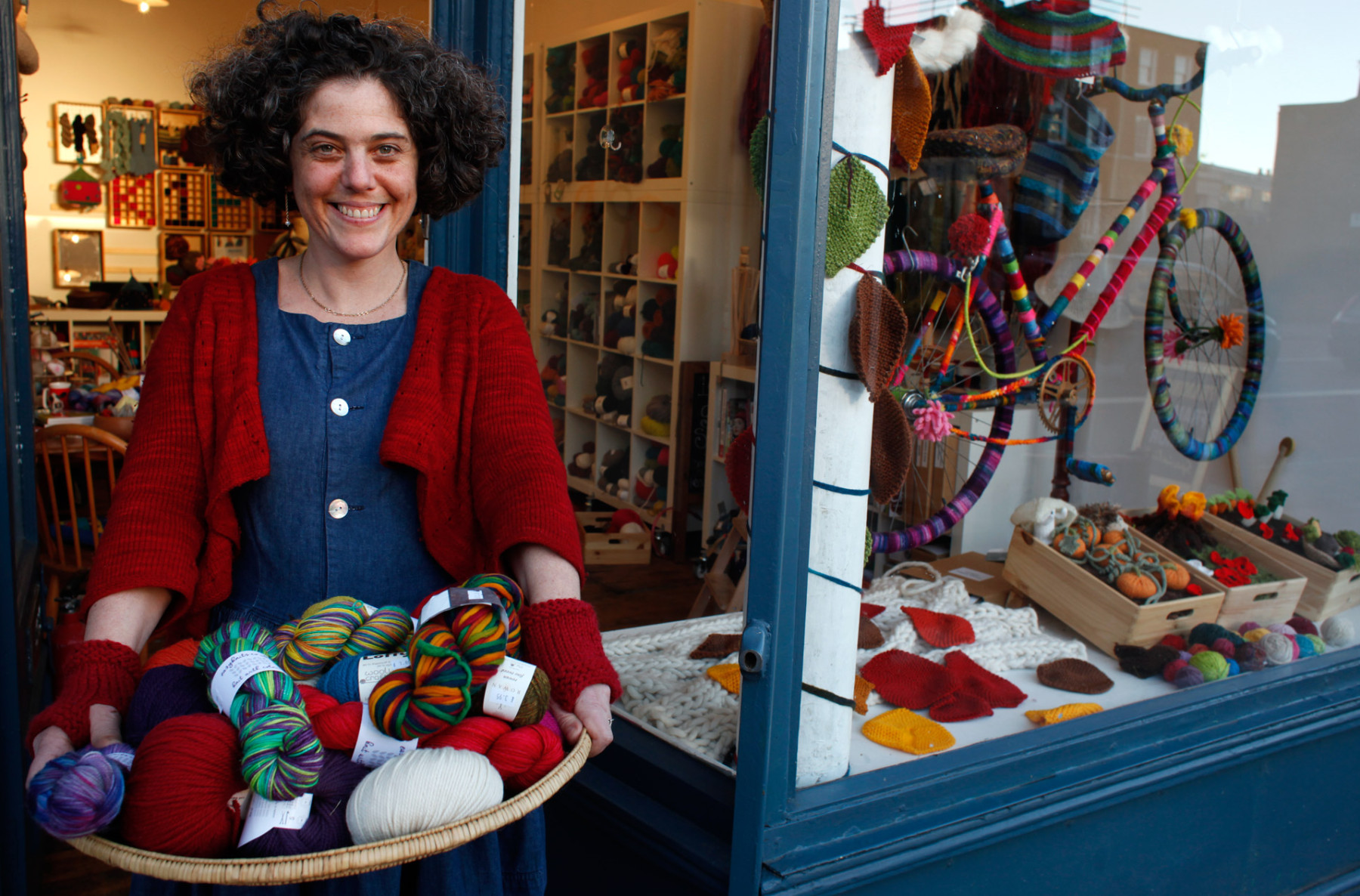In the English speaking knitting world, travelling to the Shetland islands, 130 miles north of the Scottish mainland, has become something of a Haj-like pilgrimage. Those who are lucky enough to make the journey, return with stories of mill trip adventures and fairisle masterclasses, photos of beautiful sheepy hillsides and coastline sunsets, and suitcases bursting with heathered shetland wool inspired by the same landscape colours. For those of us who have yet to go, we hold onto a dream that we’ll make it eventually. There is the sense that the richness of the islands’ knitting history will deepen and strengthen the knitterliness within us and that in Shetland we’ll get a glimpse of the bottom of the rabbit hole we’ve been falling down since we fell in love with knitting.
But last week, in the course of a day’s teaching and chatting with Shetland knitting tutor and designer, Janette Budge, my romanticisation of her world made several somersaults. I was repeatedly struck by the astonishing normalness of the way she knits and the remarkably workish space that it occupies in her life and the lives of other islanders.
‘Most girls started knitting at 4. I think I was 6. It’s just what we did.‘ she explains in an accent that seems to lilt along a Scottish-Norweigian nexus
‘My mother handknitted colourwork yokes. She got £2.50 per yoke. Oh no, she didn’t knit the whole cardigan! The plain cardigan bodies were made elsewhere on a knitting machine. She would knit the yoke and cuffs and graft them onto the machine-knitted body. She could make between 2 and 5 in a fortnight depending on the light and other tasks. We worked out that she must have made about 600 yokes in her lifetime. She was one of hundreds doing it. She can’t do it anymore as she has arthritis in her hands... Yes, it was very badly paid but in general it wasn’t for putting food on the table, it was for extras. It was different for the spinsters. For them it was their job, their main income. They depended on the money. She pauses here. ‘It was very badly paid.’ she repeats again.
Although Janette’s visit had ostensibly been about bringing 2 new techniques classes to the shop – one on fairisle knitting, the other on steeking – it soon became clear that her technical skill was so interlaced with the fabric of her life, that from gauge to picking up a buttonband, each technique turned into a window on a lifetime of knitting..
‘Oh in Shetland nobody swatches. I’ve got my hat here which I can look at if I need to know my gauge...
I don’t like to be too prescriptive about buttonbands. My mother would have said to pick up every second stitch, but some people have a different count. I make my button bands about 3 or 4 rows before the button hole, and then 5 more before I run in the tail from the cast off to keep it secure.‘

For the uninitiated, the benefit of steeking (making a channel in your knitting along which to cut your work) is that you do all your knitting in the round, even if what you’re making is going to be flat, like a blanket, shawl or cardigan. This means you don’t ever have to work on the purl or ‘wrong side’ of your fabric, which is considered better for a more even tension, and you can follow the pattern on the clearer ‘right side’. Now if taking sharp scissors to cut your pain-stakingly worked knitwear sounds like too high a price, for the benefit of staying on the right side of your knitting, Janette has a typically straight-forward alternative option..
‘There are some ladies in another part of the island who just break the yarn at the end of the row and join it in again at the beginning of the next one so that they stay on the right side. It leaves a lot of ends but they don’t bother with weaving them in. They get hidden under the button band.’
There’s a quotidien groundedness in the way she speaks about how to master these mysterious techniques, which is joyously free of grand-standing. I begin to wonder whether it is part of our metropolitan condition to be obsessed with new stuff, that makes us endlessly seek new engineering in our garment construction, for Janette’s presentation of how she’s ‘always done it’ just makes it so doable and obvious..
‘Actually I don’t remember ever calling it a steek.’ she says.
I don’t think we called it anything. My mother talked about knitting the extra bit – the button bands. So I’m not sure where the name steek comes from.
And I don’t actually bother about ribbons down inside the edge. The wool ends tend to felt together.‘

From Shetland Wool Week to countless island knitting tours to 6 new Shetland yarn producers (on top of the 2 already famous Jamiesons of Shetland and J&S): This growing recognition of Shetland’s place in the knitting canon is a change not lost on Janette..
I never realised that the quality of Shetland knitting was so special. It’s what we’ve always done. Women in Shetland knit. They knit by the fireside and on the hillside. With a knitting belt and long pins, they knit as they walk along paths to flit the cow (put it out to the hill ground away from the croft). But of course we walk those paths so often, we know them so well, we know where to step without falling.‘(as if that would be the only reason not to knit as you walk to ‘flit the cow!’)
‘If you wore an apron, you’d have the ball of wool in one of your pockets. If not you’d hook it onto your little finger like this so you could carry on knitting. Oh yes, otherwise it’d get it into a paes-wisp (all in a tangle).’
‘ It is just what we did. Why would I think it was special?’
With enormous thanks to Janette Budge, for making the long journey south, for sharing her knitting, her skill and her stories from so far away, and for becoming part of our story too.

